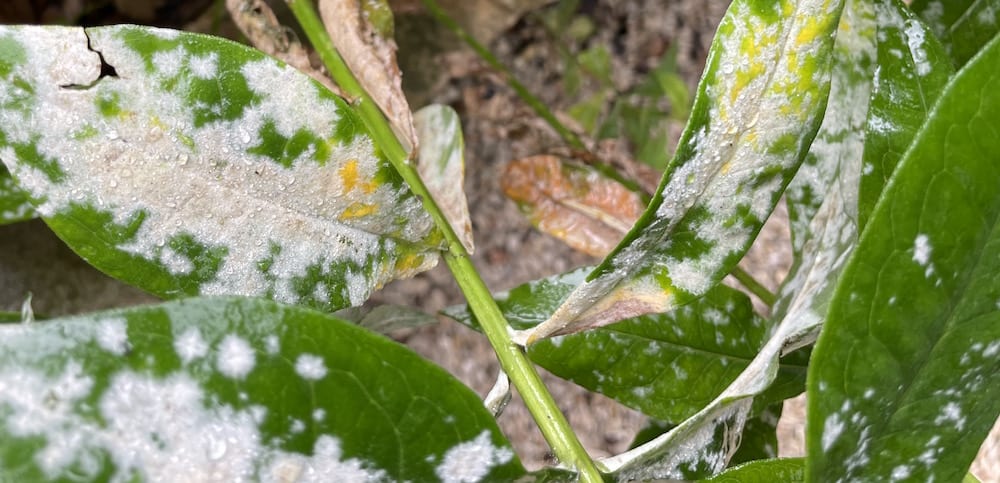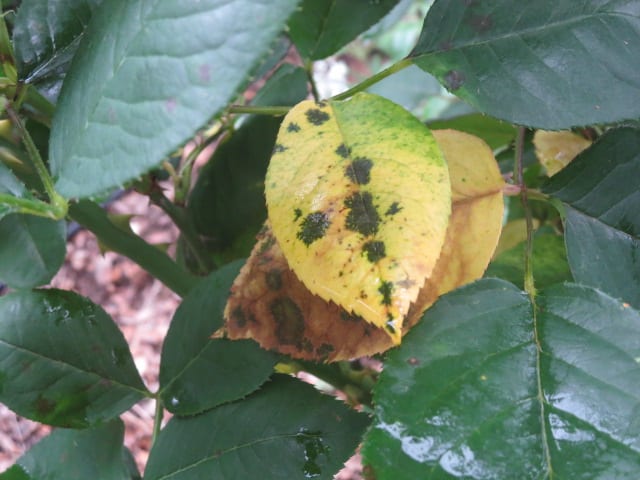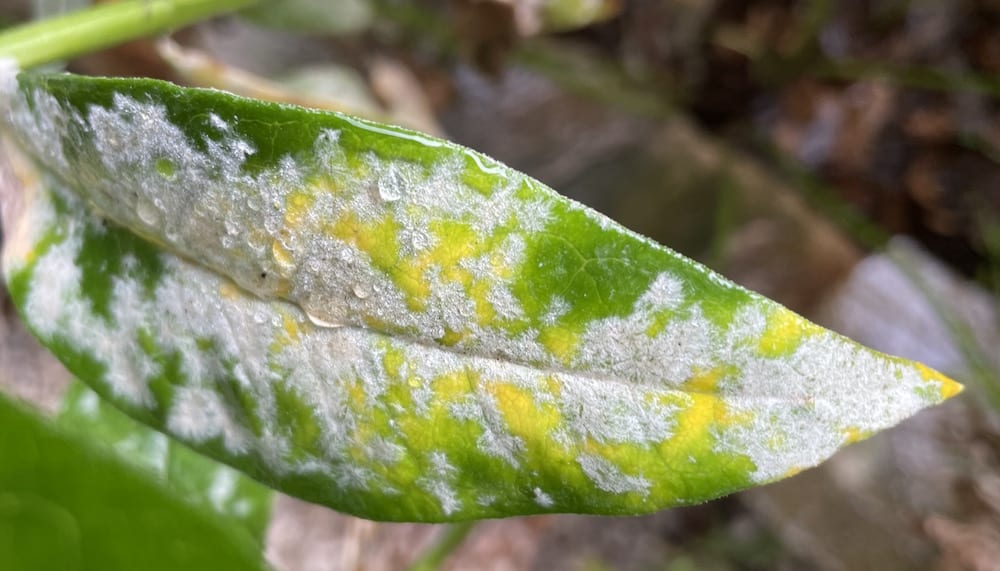While most of us appreciate free water, a.k.a. rain, we also frown when a fungus arrives due to the cloudy days that accompany it, and having too much of a good thing! When we experience heavy periods of rain, plus humidity and lots of cloudy days, fungus issues are always lurking. We open our arms in joy when the rain spurs on rapid growth of our zucchini plants and then shake our fists as gray, powdery mildew slithers across their leaves.
Besides doing your best to prevent fungus before it happens, what’s a rain-drenched gardener to do? Today we’ll talk options for treating fungus brought on by cloudy, humid weather and a little over abundance of rain.
Preventing Fungus and Disease
When weather conditions are favorable, really any plant can develop a fungus problem. You don’t have control over the weather, but you can control other aspects of care for your plants to prevent fungus like powdery mildew. Follow these guidelines for fungus prevention.
-Give plants adequate air circulation by spacing them correctly at planting time.
-Avoid watering the foliage on plants. Drip irrigation is a great help with this.
-Avoid watering plants in the evenings.
-Don’t choose cultivars that are more susceptible to developing fungus. (See more info below.)
-Mulch to prevent soil splashing up on plants which increases chance of disease.
-Offer plants correct sun exposure (powdery mildew tends to show up more in shadier areas.)


(Be observant….this natural discoloration looks similar to powdery mildew but is not!)
Treating Cloudy or Rainy Weather Fungus
Vegetables: Although unsightly, a common fungus like powdery mildew on the leaves of your veggies generally won’t cause too much damage to your veggie harvest besides a lower yield. Severe infections, however, can rob your veggies of nutrients and water and produce a pretty gnarly looking plant. Rain splashing soil on veggie plants can contribute to other fungus and disease issues too (leaf blight, etc…)
It goes without saying (or does it), that when treating veggies for fungus issues like powdery mildew, you want to be really careful and opt for an organic product that is safe to use on something you will eventually be putting in your mouth! Treat with organic products like sulfur and copper based sprays that are specifically labeled for edibles.
Some edibles that are more susceptible to developing the fungus powdery mildew are: cucumbers, squash, zucchini, pumpkins, melons, peppers, tomatoes, grapes, potatoes. This doesn’t mean you shouldn’t grow them; I’m just giving you a heads up.


On roses, black spot and powdery mildew are BFFs!
Roses: Clouds and roses generally don’t mix. We don’t know of a shade-loving rose, so when the clouds shade out the sun day after day, there is a higher chance your rose will develop some type of fungus.
Black spot and powdery mildew often like to show up together on your roses. Black spot is often prevented by avoiding wetting the foliage of roses and avoiding splashing soil up onto the foliage. How are you suppose to do that when the rain keeps coming? You can’t, you’ll have to wait for a break in the weather and then treat the fungus with a labeled fungicide. Most likely, you’ll have to follow up with subsequent applications as long as the rain keeps falling, but always thoroughly read the label.
The same treatment for black spot is used for powdery mildew. Synthetic fungus treatment products should contain the ingredient chlorothalonil (like found in Daconil) or myclobutanil (Bayer Advanced). Organic options include Neem Oil (only applied during cool morning hours or you risk burning the plant), potassium bicarbonate, sodium bicarbonate, copper sulfur sprays (apply only when temps are below 85°F… you may have to wake up early) and copper based sprays.
Ornamentals: The same synthetic or organic treatment choices mentioned above for roses can also apply to most annuals and perennials. (I’m doubling down on the sulfur and Neem Oil warning. Do not apply in temperatures 85°F or higher. Treating during cool, early morning hours are best.)
While powdery mildew generally shows up during dry but cloudy and humid periods, no break in the rain to dry things up can exacerbate the situation.
Some plants that are more susceptible to powdery mildew are: zinnia, begonias, monarda, gerbera daisy, rudbekia, phlox and crape myrtles. (We carry mildew-resistant varieties at Rainbow Gardens.)
Pollinator Plants: A special note on fungus control on pollinator plants. You have to be very careful and selective when it comes to treating any fungus issue on plants that you are growing to host, feed, and shelter pollinator plants.
You CANNOT use traditional systemic fungicides. You’ll need to choose from a potassium bicarbonate or copper sulfate control. Keep in mind that even using these gentler products for fungicide control causes a slight risk to pollinator larvae. Always thoroughly check your plants for pollinator eggs and larvae that you can transfer to another plant while you treat the affected one.
Turf: Watering lawns at night, or extended periods or rain combined with humidity can all create the perfect breeding ground for fungus to develop. Although the fungus Brown Patch usually shows in fall, we definitely have seen it develop in spring and unseasonably cool summers when there has been a lot of rain.
See the link above for symptoms of lawn fungus to see if Brown Patch or another fungus is attacking your lawn. Treatment options include systemic lawn fungicides like: Fertilome F-Stop, Bonide Infuse, Bayer Advanced Fungus Control.
In summary, we need a little time to dry out a bit between waterings, and we need some sunshine! Last minute thoughts are: early detection is best, repeat applications may be necessary depending on product and duration of rainfall, and lastly, this too shall pass. It will be scorching hot here without a drop of water in sight. Don’t you worry!
~The Happy Gardener, Lisa Mulroy


Great information. Thank you
Thank YOU for taking the time to read our blog! Much appreciated!
Thanks for info. But one thing to note regarding mulch and vegatables… Mulch and all this “moisture” is a dog-whistle to pill bugs!! And they will devour stems, leaves and all those lovely late Spring young fruits!! One thinks they have beat the dreaded Squash vine borers and now it’s the Battle of the Pill! 😉
Oh for sure the rain will bring out the pill bugs, slugs, and snails! We have some great info on our Pest page on our website for battling these too, but it can be difficult when the prime conditions keep calling these pests in! It’s a battle out there!
Mildew and black spot are so frustrating to treat especially when you do not see results. Patience and sunshine. Thank you for the information.
Patience and sunshine, two building blocks of gardening! Love it. Thank you for taking the time to read!